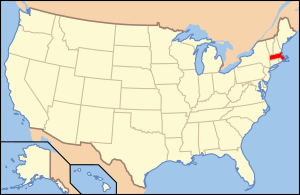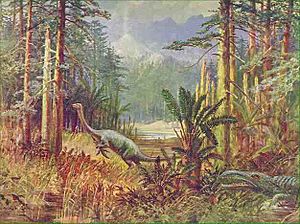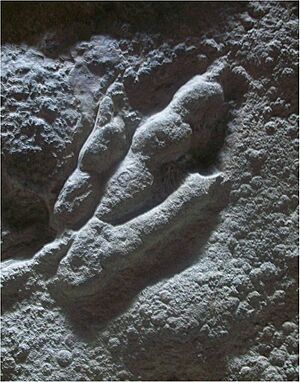Paleontology in Massachusetts facts for kids

Paleontology in Massachusetts is all about finding and studying fossils in the U.S. state of Massachusetts. It's a lot like the fossil hunting in nearby Connecticut.
Millions of years ago, during the early Paleozoic era, Massachusetts was covered by a warm, shallow sea. Creatures like brachiopods (shellfish) and trilobites (ancient sea bugs) lived there. We don't have many fossils from the Carboniferous or Permian periods in the state.
Later, during the Cretaceous period, areas like the Elizabeth Islands and Martha's Vineyard were a coastal plain. This plain had flowers and pine trees growing near a shallow sea. There are no rocks from the Paleogene or early Neogene ages here. But during the Pleistocene Ice Age, huge glaciers covered the state. Mastodons, which were like giant hairy elephants, lived here then.
Interestingly, some local theropod (meat-eating dinosaur) footprints might have inspired a legend. The Tuscarora people in New York had a story about a "Mosquito Monster" or "Great Mosquito."
Scientists noticed local fossils early on. In 1802, dinosaur footprints were found. Other cool discoveries include some of the first known fossils of early sauropodomorphs (long-necked dinosaurs). Also, the small dinosaur Podokesaurus was found here. Dinosaur tracks are even the official state fossil of Massachusetts!
Contents
Ancient Times in Massachusetts
Massachusetts doesn't have any Precambrian fossils. So, the state's fossil record starts in the Paleozoic era. Back then, a warm, shallow sea covered the area. Brachiopods and trilobites left their fossils behind.
The Carboniferous rocks in Massachusetts have changed a lot over time. This means they don't usually have fossils. The Permian period is missing from the state's rock record. This is because old sediments were wearing away instead of new ones being laid down.
During the Cretaceous period, the land where the Elizabeth Islands and Martha's Vineyard are now was a coastal plain. It was close to a shallow sea. Flowering plants and pine trees grew on this plain.
The Tertiary period of the Cenozoic era is another gap in the state's rock record. However, during the Pleistocene epoch, huge glaciers moved into the state. These glaciers left behind sediments. These sediments preserved mastodons and molluscs (like snails and clams) at Cape Cod.
History of Discoveries
Early Fossil Finds
One of the first big fossil finds in Massachusetts happened in the spring of 1802. A farmer named Pliny Moody was plowing his field in South Hadley. He found a reddish sandstone rock with bird-like, three-toed footprints.
More fossil footprints were found in 1835. The town of Greenfield, Massachusetts, was paving roads. Workers saw footprints on the sandstone slabs that looked like turkey tracks. These rocks came from Turners Falls. This spot became the best place to find dinosaur tracks in the Connecticut Valley.
Later that year, a local doctor and naturalist, James Deane, heard about the footprints. He was very curious! Deane wrote to Edward B. Hitchcock, a geology professor at Amherst College. Professor Hitchcock spent that summer exploring the Connecticut Valley. He looked at many fossil footprints.
In 1836, Hitchcock wrote a scientific paper about the footprints. He thought giant birds made the tracks. In 1843, James Deane also started publishing his findings on the Connecticut Valley track fossils. In 1847, a type of fossil track was named Otozoum moodi after Pliny Moody.
Mid-1800s Discoveries
In 1855, William Smith found fossil bones. This happened while workers were blasting for renovations at the US Armory in Springfield, Massachusetts. Many fossils had already been taken away. General Whitney, who was in charge, ordered that the remaining fossils be checked.
William Smith showed the fossils to Edward Hitchcock. Hitchcock then gave them to Jeffries Wyman. The fossils included bones from a spine, a hand, and parts of a hip and leg. Later that year, Amherst College built the Appleton Cabinet. This building was made to hold the dinosaur tracks that Edward Hitchcock had collected and studied.
In 1858, Hitchcock published more about the Connecticut Valley fossil footprints. He still thought they were bird tracks. He grouped the trackmakers by whether their toes were thick or thin. Hitchcock passed away in 1864. The next year, a book he had written about the tracks was published after his death.
In 1865, the fossils found at the Springfield Armory finally got a name. Sir Richard Owen in England studied them. He named them Megadactylus polyzelus.
Twentieth Century Finds

Important things happened in Massachusetts paleontology in the early 1900s too. In 1904, Richard Swann Lull published his first study of the Connecticut Valley fossil footprints.
Five years later, in 1909, Massachusetts paleontologist Mignon Talbot made history. She became the first woman elected to the Paleontological Society. In October the next year, Mignon Talbot found a partial dinosaur skeleton. She found it in a gravel pit near South Hadley Center. This discovery is called "the most prized specimen" at Mount Holyoke College's geological museum. It was also seen as the last big find in the "Connecticut Valley 'bone rush'."
That December, Talbot talked about her dinosaur discovery to the Paleontological Society. She thought the skeleton belonged to a plant-eating dinosaur. In 1911, Mignon Talbot and Richard Swann Lull worked together. They wrote a description of the dinosaur found in South Hadley. They realized Talbot had been wrong about it being a plant-eater. They reclassified it as a meat-eating dinosaur (theropod). They named it Podokesaurus holyokensis.
Six years later, in 1916, a fire destroyed Williston Hall at Mount Holyoke College. The bones of Podokesaurus holyokensis were lost. However, copies (casts) of the bones had been made earlier. These copies still exist at Yale's Peabody Museum and New York's American Museum of Natural History.
Almost two decades later, in 1933, Carlton S. Nash found Early Jurassic dinosaur footprints. He found them in Portland Formation rock near South Hadley. This was close to where Pliny Moody made his early discovery. Around 1939, Nash bought the land where he found the footprints. He started Nash Dinosaurland, selling dinosaur tracks to people all over the world.
In 2021, a new Neotheropod dinosaur was found. It was discovered by Mark McMenamin from a partial arm bone. Scientists think it was about 9 meters (30 feet) long. It might have even lived partly in water.
Natural History Museums
- Amherst College Museum of Natural History, Amherst
- Berkshire Museum, Pittsfield
- Cape Cod Museum of Natural History, Brewster
- Harvard Museum of Natural History, Cambridge
- Marion Natural History Museum, Marion
- Museum of Science, Boston
- Natural Science Museum in Hinchman House, Maria Mitchell Association, Nantucket
Private and Commercial Places
- Nash Dinosaurland
Events
- East Coast Gem, Mineral & Fossil Show


